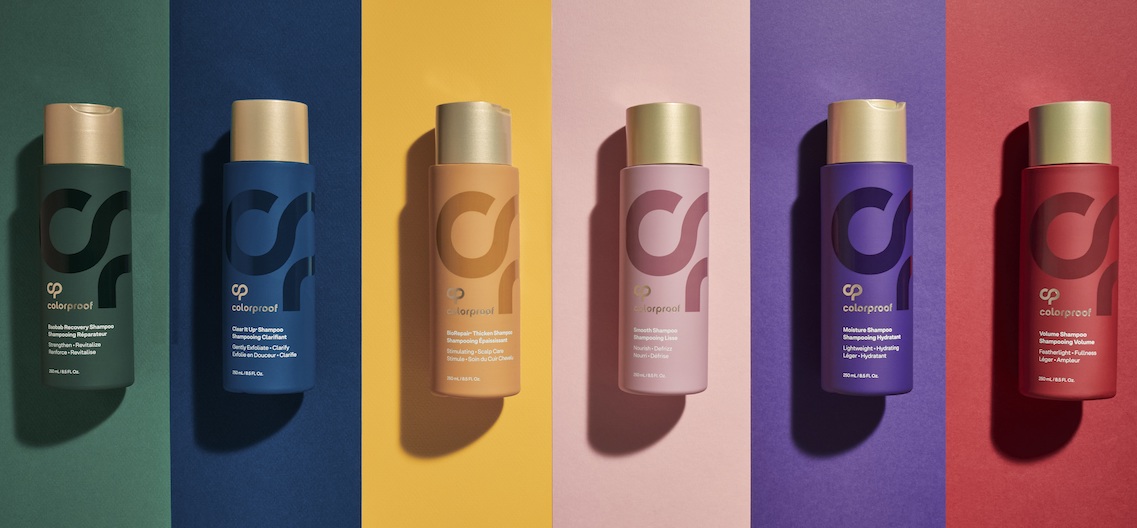Colorproof is going through a big and bold rebrand, as it aims to keep pace with today’s hair-care market.
The Colorproof rebrand runs the gamut, from introducing a new logo to reformatting the portfolio and packaging, to reformulating the products. The majority of Colorproof’s sales are through the professional channel, with distribution in over 12,000 salons. Colorproof was founded in 2012 and acquired in June 2020 by beauty manufacturer Cosway Co. Since its launch, color-safe hair care has become table stakes for hair-care brands and also more accessible, as many brands have shifted away from using sulfates and other color-stripping ingredients. As such, simply being a color-safe brand is no longer enough, said Maureen Saenz, vp of marketing at Colorproof. Now, Colorproof is restaging itself as a color preservation and amplification brand.
“We are using this restage as an opportunity to optimize [the brand],” said Saenz. “We took a similar approach [to the evolution of the iPhone]. Let’s take what we have learned and optimize where we need to, with the latest and greatest [features], but also keep the things that our loyal customers love about us.”
Colorproof sent a survey to salons and distributors in mid-2020, gathering feedback about the brand and its reception in the market. It was found that, while the professional channel liked the products and formulations, end-users did not resonate with the brand, Saenz said. Specifically, the packaging did not appeal to them. Plus, the product portfolio had been bloated to over 100 products with confusing names. As a result, “Crazy Smooth Extreme Shine Treatment Oil,” was renamed to “Smooth Drops,” for example. The relaunch also consists of elevated packaging designs, including jewel-toned bottles and gold caps, and a tighter assortment of approximately 55 products across seven collections. The collections are focused on moisture, volume, smoothing, thickening, recovery, essentials and styling. An eighth collection focused on toning debuts in the summer.
The most recent NPD Group sales data show that the hair-care category grew by 47% in 2021, compared to the year prior. Within the hair category, hairsprays, gels, mousses and other styling products returned to growth in 2021, with hair-styling product sales up 45% versus 2020. The hair-styling segment is expected to rise another 15% in 2022. Meanwhile, the hair-dye category experienced a 17% lift in year-over-year sales between Jan. 2021 and Nov. 2021, and a 77% increase compared to the same time in 2019.
“We’re continuing to see color grow. And with Covid-19, there’s definitely a push to maintain the health and care of your hair,” said Kristen Turner, director of marketing for Colorproof.
With the rebrand, Colorproof invested in a large-scale campaign for the first time in three years. Colorproof is using the imagery in social media posts across Facebook and Instagram and is focused on providing “A-plus” content, said Saenz. That includes short video clips, infographics and elevated model imagery. Colorproof first teased the rebrand in Oct. 2021 when it formed a new Instagram account @ColorproofHair. However, its original account, @ColorproofHair_, which has more than 41,000 followers, remains active until after the official launch.
Ad position: web_incontent_pos1
Colorproof will introduce unique assets and new promotions for its professional channel, including a customizable digital catalog for sales reps and salons and a bi-monthly sampling product program called Pop of Colorproof. Salons can purchase a travel-size product and get a second one free to sample to their clients. A new program called Color Crush, driven by brand reps, provides stylists with a deep dive on select products. It is meant to offer more engaging education and even provide social posts for salons to share on their own channels. Salons can access this through the professional portal on Colorproof.com.
“We wanted to connect with the idea of the joy that consumers experience when they get their hair done or when you get their hair colored,” said Saenz. “You’re going to see that in the packaging, the messaging, the creative assets. There’s always going to be a callback to that sense of joy.”




